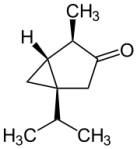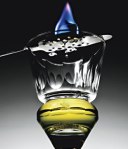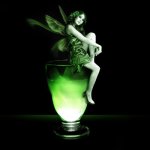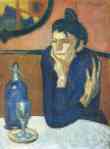Understanding Absinthe
Contributed by on Oct 12, 2013
Two readers love this post.
There is no absence of malice when it comes to understanding absinthe (absinthe of malice....?). In fact I hear more wives' tales, misconceptions, and some just flat-out propaganda that rivals the crap that almost got absinthe banned worldwide.
WORMWOOD AND THUJONE
 Absinthe is an herbal liqueur that originated in Switzerland and is named from its primary herb Artemisia absinthium aka wormwood along withanise, fennel and many other herbs. Wormwood like many other plants contains a chemical called Thujone. Thujone is a Gamma-aminobutyric acid (GABA) inhibitor meaning that it blocks GABA receptors in the brain and in extreme doses can cause convulsions. Other herbs that contain thujone are oregano and sage.
Absinthe is an herbal liqueur that originated in Switzerland and is named from its primary herb Artemisia absinthium aka wormwood along withanise, fennel and many other herbs. Wormwood like many other plants contains a chemical called Thujone. Thujone is a Gamma-aminobutyric acid (GABA) inhibitor meaning that it blocks GABA receptors in the brain and in extreme doses can cause convulsions. Other herbs that contain thujone are oregano and sage.
No absinthe in the history of the world has contained enough thujone to inhibit brain function! I mean it! But we will get back to this in a minute
STYLES OF ABSINTHE
There are three basic styles of absinthe:
Swiss is the original as I said, then there is French and Czech. Swiss is a milder balanced style where the anise flavors are not as prominent. French is typically more anise forward and colored green and tends to be a sweeter in flavor. Czech "absinth" is artificial and should be avoided as is it usually just high-proof booze with macerated wormwood only and not a distilled as traditional absinthe. It is more like bitters actually. Czech or Bohemian "absinth" even drops the "e" from its name. Whether that be a language thing or an omission to dodge European regulation try to stay away from any bottle of absinthe without an"e" on the end.
HOW TO DRINK
Again three ways to do this:
 Absinthe lends itself to high-proof and is intended to be watered down, and some sweetened with sugar. Why add sugar to a liqueur? Well keep in mind in absinthe's hay-day, the average palate preferred their drinks sweeter than we do today. Also wormwood like many other herbs and in turn bitters, liqueurs, and spirits were prescribed by pharmacologist and traditionally one would take their medicine with sugar and water (remember what Mary Poppins taught us?)
Absinthe lends itself to high-proof and is intended to be watered down, and some sweetened with sugar. Why add sugar to a liqueur? Well keep in mind in absinthe's hay-day, the average palate preferred their drinks sweeter than we do today. Also wormwood like many other herbs and in turn bitters, liqueurs, and spirits were prescribed by pharmacologist and traditionally one would take their medicine with sugar and water (remember what Mary Poppins taught us?)
The absinthe "ritual" is the same between Swiss (Suisse) and French with one exception.
 Take a fluted glass and on top of the glass place a slotted spoon (Absinthe spoons are remarkably similar to julep strainers......I did say medicinal!). Atop the spoon place a sugar cube, however depending on the sweetness of your chosen absinthe and your personal taste, sugar may not be necessary (the ones I have at home are 1/2 sized cubes for this very reason). But let's go with the sugar for now. Pour one ounce of absinthe over the sugar cube into the glass. Now here is where we distinguish styles. For Swiss style you would now ignite the absinthe soaked sugar cube to caramelize the sugar. For French leave you lighter in your pocket. One is neither better or more proper other than maybe matching the style of drinking to the style of absinthe. Next is cold water. You can buy an Absinthe drip that regulates the speed of ice-cold water dripping over the sugar cube or you can do what I do at home and use an old pint bottle with a pour spout.
Take a fluted glass and on top of the glass place a slotted spoon (Absinthe spoons are remarkably similar to julep strainers......I did say medicinal!). Atop the spoon place a sugar cube, however depending on the sweetness of your chosen absinthe and your personal taste, sugar may not be necessary (the ones I have at home are 1/2 sized cubes for this very reason). But let's go with the sugar for now. Pour one ounce of absinthe over the sugar cube into the glass. Now here is where we distinguish styles. For Swiss style you would now ignite the absinthe soaked sugar cube to caramelize the sugar. For French leave you lighter in your pocket. One is neither better or more proper other than maybe matching the style of drinking to the style of absinthe. Next is cold water. You can buy an Absinthe drip that regulates the speed of ice-cold water dripping over the sugar cube or you can do what I do at home and use an old pint bottle with a pour spout.
 Now its time to watch. Your absinthe will begin to change, morphing from its clear, pale or green self into a rich milky goodness. This is called the Louche and mystically referred to as releasing of the Green Fairy. The louche is the release of the essential oils in the absinthe and will tell you many things about the quality and flavor of your absinthe. Depending on the proof of you absinthe anywhere from 3 to 5 ounces of cold water should do you.
Now its time to watch. Your absinthe will begin to change, morphing from its clear, pale or green self into a rich milky goodness. This is called the Louche and mystically referred to as releasing of the Green Fairy. The louche is the release of the essential oils in the absinthe and will tell you many things about the quality and flavor of your absinthe. Depending on the proof of you absinthe anywhere from 3 to 5 ounces of cold water should do you.
The third style of absinthe prep, oddly comes from our Czech friends. And it is called "the Huff" or "Huffing Ritual'. Take a glass that you can fit your palm over. Pour absinthe into the glass and ignite the absinthe itself. Wait about 20 seconds the cover the glass with you hand tightly which will create a vacuum between your palm and the glass. Lift the glass o your mouth between your thumb and forefinger. Break the seal, huff the fumes, then drink the shot. You see a pattern forming here? This, like Czech absinth, is designed for a single purpose and that is not the appreciation of a spirit. Not saying I haven't participated in the style of drinking before.
REAL ABSINTHE IN THE U.S.
Yes it is real. Remember the thujone thing earlier? Absinthe contains anywhere from 5 to 35 parts per million (ppm) of thujone. Even the stuff pre-prohibition was around this amount. In 2007 the U.S. began allowing absinthe to be imported that they consider "thujone free" which is 10 ppm or less. Some, however, would have you think that free means zero, and the more thujone the better the absinthe (wanna guess who...?). Again there is not enough thujone is any absinthe to set off your GABA receptors.
SO WHY DO I FEEL DIFFERENT DRINKING ABSINTHE THAN OTHER BOOZE?
Well specifically with absinthe it is probably the anise either green and especially star anise along with the other herbs that make up the flavor. remember herbs have medicinal qualities and between the distillation process and the louche enhancing the essential oils, we are taking in stuff that affects the body differently than other spirits.
There are other liqueurs that affect the body as well: Chartreuese, Ouzo, Sambucca, and Jagermeister to name a few.
ABSINTHE AND HALLUCINATIONS
 Nope. Not at all. Again this is leftover propaganda from a hundred years ago where teetotalers and the temperance movement published "facts" stating that absinthe was more addictive and dangerous than opium. Add this to extreme examples of heavy alcoholism in people like Van Gogh, Picasso, and Hemingway, and you got yourself quite a smear campaign!
Nope. Not at all. Again this is leftover propaganda from a hundred years ago where teetotalers and the temperance movement published "facts" stating that absinthe was more addictive and dangerous than opium. Add this to extreme examples of heavy alcoholism in people like Van Gogh, Picasso, and Hemingway, and you got yourself quite a smear campaign!
Later I shall share the story of the history of all these little myths, but for now sit back and enjoy a great absinthe cocktail.
For more info how absinthe please visit
